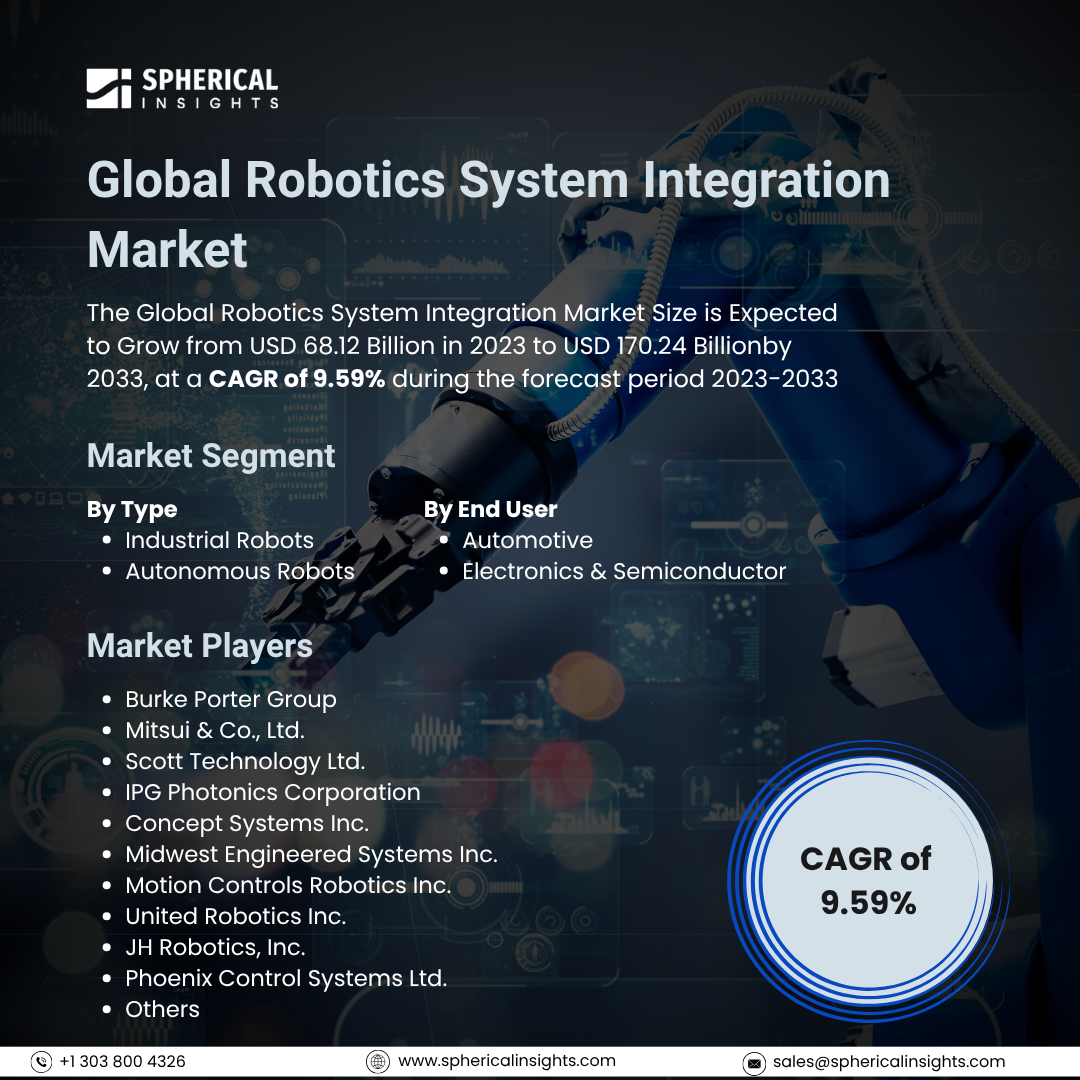Global Robotics System Integration Market Size To Exceed USD 170.24 Billion By 2033
According to a research report published by Spherical Insights & Consulting, The Global Robotics System Integration Market Size is Expected to Grow from USD 68.12 Billion in 2023 to USD 170.24 Billion by 2033, at a CAGR of 9.59% during the forecast period 2023-2033.
Browse 210 market data Tables and 45 Figures spread through 190 Pages and in-depth TOC on the Global Robotics System Integration Market Size, Share, and COVID-19 Impact Analysis, By Type (Industrial Robots and Autonomous Robots), By End User (Automotive and Electronics & Semiconductor), and By Region (North America, Europe, Asia-Pacific, Latin America, Middle East, and Africa), Analysis and Forecast 2023 – 2033
The global robotics system integration market refers to the industry focused on combining hardware, software, and robotic systems to create fully functioning and effective automation solutions for an assortment of applications. In this market, industrial robots, robots that collaborate (cobots), and service robots are integrated into an assortment of industries, including healthcare, electronics, manufacturing, logistics, and automotive. Key driving factors for the growth of the robotics system integration market include the increasing demand for automation, especially in the manufacturing, automotive, electronics, and logistics sectors, which is an important consideration as businesses look for ways to increase productivity, cut expenditures, and improve the standard of their products. Technological developments in robotics, including computational intelligence (AI), machine learning, and computer vision, are enhancing the cognitive abilities and adaptability of robots and promoting their more widespread adoption. However, a lack of competent workers, high initial investment prices, complicated integration procedures, and low awareness among small companies are the primary obstacles restricting the global robotics system integration market's expansion.
The industrial robots segment accounted for the largest revenue share in 2023 and is projected to grow at a significant CAGR during the forecast period.
On the basis of type, the global robotics system integration market is divided into industrial robots and autonomous robots. Among these, the industrial robots segment accounted for the largest revenue share in 2023 and is projected to grow at a significant CAGR during the forecast period. The segment growth is attributed to increasing labor costs, the need for automation, improvements in AI and vision technologies, and their worldwide adoption in the electronics, automotive, and manufacturing industries.
The automotive segment accounted for the largest market share in 2023 and is anticipated to grow at a remarkable CAGR during the forecast period.
On the basis of end user, the global robotics system integration market is divided into automotive and electronics & semiconductor. Among these, the automotive segment accounted for the largest market share in 2023 and is anticipated to grow at a remarkable CAGR during the forecast period. The growth segment is driven because the automotive machines market is expanding due to developments in robotic painting technologies, the need for improved finish quality and cost reduction, and the demand for sustainable, high-throughput production.
North America is anticipated to hold the largest share of the global robotics system integration market over the predicted timeframe.
North America is anticipated to hold the largest share of the global robotics system integration market over the predicted timeframe. The regional market growth can be attributed to its advanced technological infrastructure, widespread industry use of automation, substantial government backing, substantial R&D expenditures, and the existence of prominent robotics and integration solution providers.
Asia Pacific is expected to grow at the fastest CAGR in the global robotics system integration market during the forecast period. The regional market growth is driven because of significant automation expenditures, the rapid expansion of manufacturing industries like electronics and automotive, and substantial government backing for industrial digitalization. By establishing smart industrial programs and providing incentives for the adoption of new technologies, nations like China, Japan, South Korea, and India are leading this development.
Company Profiling
Major vendors in the global robotics system integration market are Burke Porter Group, Mitsui & Co., Ltd., Scott Technology Ltd., IPG Photonics Corporation, Concept Systems Inc., Midwest Engineered Systems Inc., Motion Controls Robotics Inc., United Robotics Inc., JH Robotics, Inc., Phoenix Control Systems Ltd., and Others.
Key Target Audience
- Market Players
- Investors
- End-users
- Government Authorities
- Consulting and Research Firm
- Venture capitalists
- Value-Added Resellers (VARs)
Recent Development
- In March 2025, KNAPP introduced AeroBot, a storage robot system that complements existing automated storage solutions. AeroBot features standardized components for easy installation and startup, aiming to maximize storage density in e-commerce and manufacturing sectors.
Market Segment
This study forecasts revenue at global, regional, and country levels from 2023 to 2033. Spherical Insights has segmented the global robotics system integration market based on the below-mentioned segments:
Global Robotics System Integration Market, By Type
- Industrial Robots
- Autonomous Robots
Global Robotics System Integration Market, By End User
- Automotive
- Electronics & Semiconductor
Global Robotics System Integration Market, Regional
- North America
- Europe
- Germany
- Uk
- France
- Italy
- Spain
- Russia
- Rest of Europe
- Asia Pacific
- China
- Japan
- India
- South Korea
- Australia
- Rest of Asia Pacific
- South America
- Brazil
- Argentina
- Rest of South America
- Middle East & Africa
- UAE
- Saudi Arabia
- Qatar
- South Africa
- Rest of the Middle East & Africa



